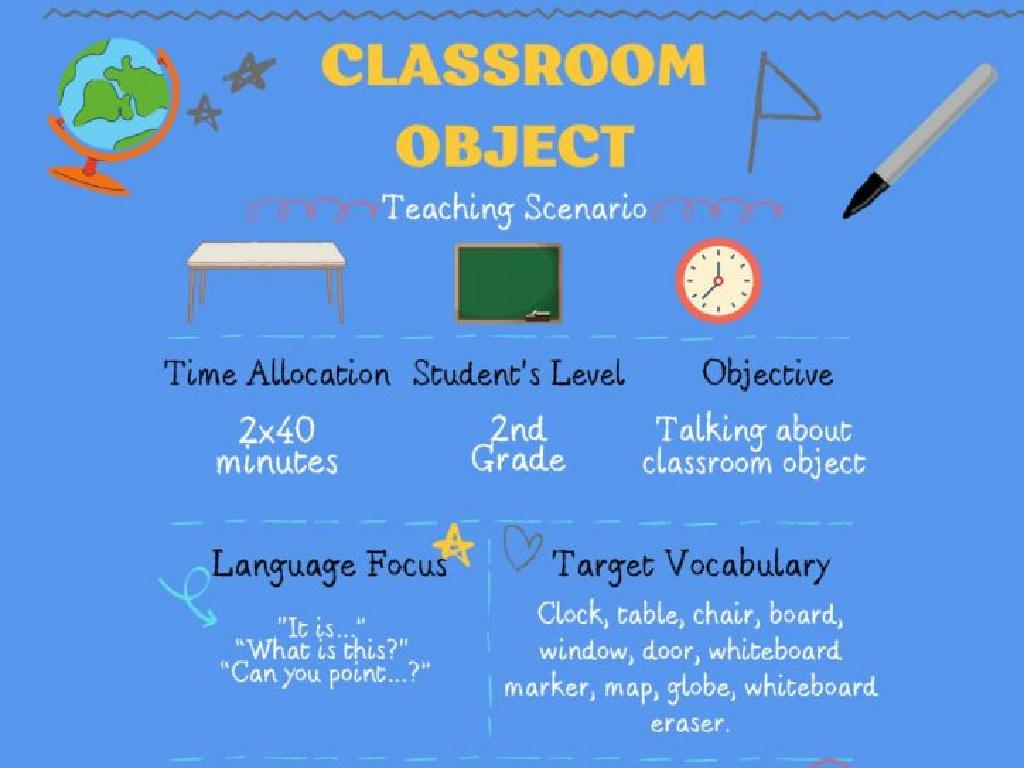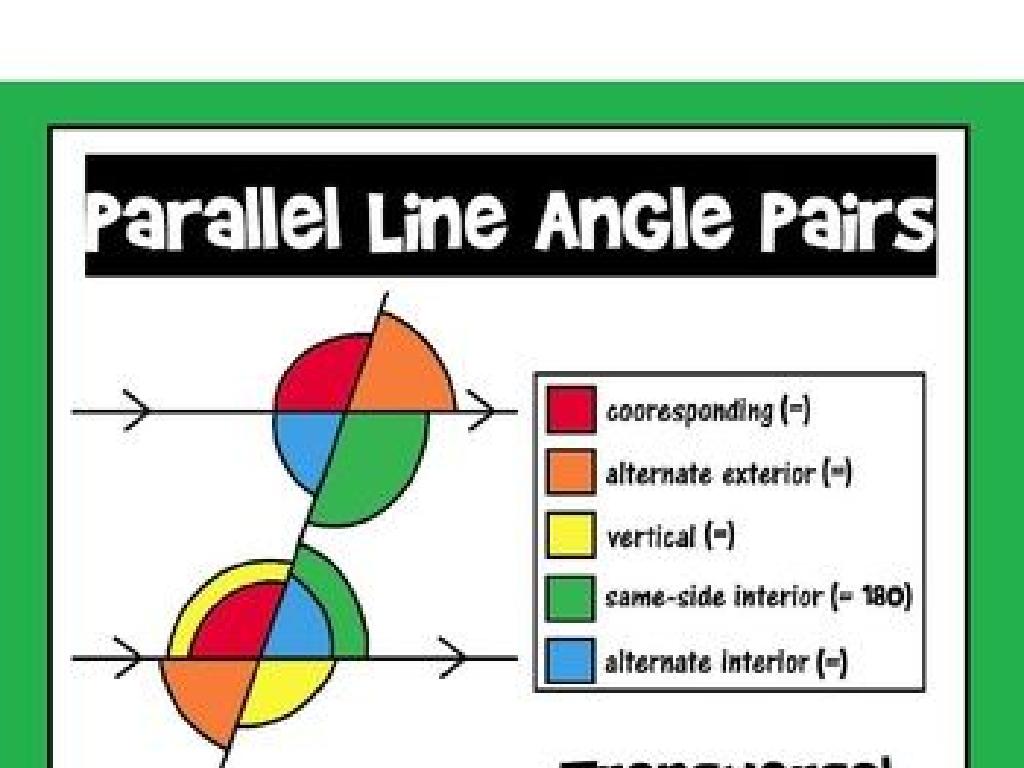Do You Have Enough Money? - Up To $5
Subject: Math
Grade: Second grade
Topic: Money Up To $5
Please LOG IN to download the presentation. Access is available to registered users only.
View More Content
Introduction to Money: Understanding Value
– What is money?
– Types of money: coins and bills
– Pennies, nickels, dimes, quarters, and dollar bills
– Each type has a different value
– A penny is $0.01, a nickel is $0.05, and so on
– Practice recognizing and using money
– Use play money to simulate buying and making change
|
This slide introduces students to the concept of money, which is a medium of exchange for goods and services. Explain that there are different forms of money, such as coins and bills, and each has a distinct value. Use real or play money to show each coin and bill, and discuss their values (e.g., 1 penny = $0.01, 1 nickel = $0.05, 1 dime = $0.10, 1 quarter = $0.25, and 1 dollar bill = $1.00). Engage the students in activities where they practice identifying and counting money, understanding how different combinations of coins can add up to the same value, and how to make simple transactions up to $5.00. This practical approach helps students apply math skills to real-life situations and builds a foundation for financial literacy.
Recognizing Coins
– Identify penny, nickel, dime, quarter
– A penny is worth 1 cent, a nickel is 5, a dime is 10, and a quarter is 25.
– Learn the value of each coin
– Knowing coin values helps us check if we have enough money for things we want.
– Fun facts about coins
– The penny has Abraham Lincoln on it, the nickel shows Thomas Jefferson, the dime features Franklin D. Roosevelt, and the quarter has George Washington.
|
This slide introduces students to the basic coins used in the United States currency system. It’s important for students to be able to identify each coin by its name, understand its value, and learn a fun fact to help remember them. For example, a penny is the smallest value coin, and it’s the only one that’s copper-colored. Encourage students to bring in some coins for the next class to practice identifying and counting them. This will help them become more familiar with using money in real-life situations. Additionally, share with them that the faces on the coins are of important historical figures, which can be a bridge to learning more about American history.
Recognizing Bills: Do You Have Enough Money?
– Identify $1 and $5 bills
– A $1 bill is called George, and a $5 bill is called Abraham
– Learn the value of bills
– $1 is for small buys; $5 is for bigger items
– Understand bill values
– Knowing bill values helps decide if you can buy something
– Discuss bill value importance
– It’s important to recognize money to make smart choices
|
This slide aims to teach students how to recognize and understand the value of money, specifically the $1 and $5 bills. Start by showing the students real bills or pictures of the bills and pointing out the differences. Explain that the $1 bill is often used for smaller purchases, while the $5 bill can be used for slightly larger items. Emphasize the importance of knowing the value of each bill to make good buying decisions. Engage the students by asking them what they could buy with $1 or $5. This will help them relate the concept of money value to their everyday lives.
Counting Money Up to $5
– Learn to count coins and bills
– Identify and add the value of pennies, nickels, dimes, quarters, and dollar bills.
– Practice with real-life examples
– Use examples like buying a toy or a snack to practice counting.
– Tips for accurate counting
– Count twice and group coins to keep track.
– Understanding money value
|
This slide aims to teach second graders the basics of counting money up to $5. Start by introducing the different coins and bills and their values. Use everyday examples, such as purchasing small items, to make the practice relatable. Provide tips like counting twice to avoid mistakes and grouping similar coins together to make counting easier. Emphasize the importance of understanding the value of money in real-world situations. Encourage students to practice with real or play money to reinforce the lesson.
Making Smart Purchases: Do You Have Enough Money?
– Learn to understand item costs
– Items have price tags, like $2 for milk
– Check if your money is enough
– Count your money, like $1 + $1 + $1 = $3
– Practice with everyday items
– Pretend to buy a toy for $4 with your $5
– Use real coins for learning
– Handling coins helps understand spending
|
This slide aims to teach students the concept of money and making purchases. Start by explaining that every item we buy has a cost, which is the amount of money we need to pay for it. Show them how to check if they have enough money by counting their coins and bills. Use real-life examples such as buying a toy or a snack to make the lesson relatable. Encourage hands-on practice by using play money or real coins to simulate purchases, which will help them understand the value of different denominations and improve their counting skills. The goal is for students to confidently determine if they have enough money to buy an item without overspending.
Calculating Change: Do You Have Enough Money?
– Understanding what change is
– Change is the money you get back when you pay more than the cost.
– Steps to calculate change
– Subtract the item’s cost from the amount you paid.
– Example: Buying a toy
– If a toy costs $3 and you pay with a $5 bill, how much change do you get?
– Practice with real-life items
– Use item prices up to $5 and different bills to calculate change.
|
This slide introduces the concept of calculating change, which is an essential life skill. Begin by explaining that change is the money received back when a purchase amount is less than the money given to the cashier. Demonstrate how to calculate change with a simple subtraction method. Use an example such as buying a toy to make it relatable for second graders. Encourage students to think of items they might buy, such as snacks or small toys, and practice calculating change using different bills up to $5. This will help them understand the value of money and improve their subtraction skills.
Class Activity: Shopping Spree
– Understand using money to buy items
– Use play money for purchases
– Pretend to buy toys or books with play money
– Calculate enough money for items
– Add up item prices, compare with your money
– Determine change received
– Subtract item cost from your money to find change
|
This activity is designed to help students apply their understanding of counting money and making transactions. Provide each student with play money up to $5. Set up different ‘store’ stations with items labeled with prices. Students will visit these stations and choose items to ‘purchase.’ They must then determine if the total cost is within their budget and calculate the change they should receive after the transaction. This practical exercise reinforces their arithmetic skills and introduces basic financial literacy concepts. Possible variations of the activity could include offering discounts, dealing with taxes, or handling incorrect change to challenge students further.
Money Matters: Review & Importance
– Recap: Counting coins and bills
– Why money skills matter
– Helps with buying things, saving, and making choices
– Practice makes perfect
– Try playing store or setting a savings goal
– Talk about money at home
– Share what you learned with family
|
As we conclude today’s lesson on money, it’s important to review the key concepts of identifying and counting coins and bills up to $5. Understanding money is crucial for making everyday decisions, such as knowing if you have enough to purchase an item. Encourage students to continue practicing these skills at home, perhaps by playing ‘store’ with their parents or setting a small savings goal to understand the value of money. Engaging with family members about what they’ve learned can reinforce these concepts and help them apply these skills in real-life situations.






